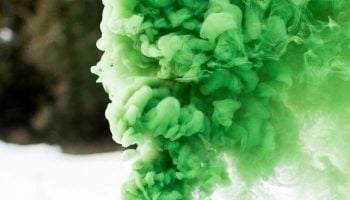The Ultimate Guide to
DMT
(The Spirit Molecule)
DMT is a potentially illegal substance, and we do not encourage or condone the use of this substance where it is against the law. However, we accept that illegal drug use occurs, and believe that offering responsible harm reduction information is imperative to keeping people safe. For that reason, this guide is designed to ensure the safety of those who decide to use the substance.
Overview
01People also ingest DMT in crystal form, smoking it in a pipe or bong, as well as vaporized. This form of ingestion produces a powerful but short-lasting hallucinogenic state, considered to be one of the most intense psychedelic experiences in existence.
It can also retain its psychoactive properties in other forms, including psilocybin (4-PO-HO-DMT, found in psilocybin mushrooms).
Many often confuse DMT with 5-MeO-DMT, or 5-Methoxy-N,N-Dimethyltryptamine, which is also a hallucinogenic compound. 5-MeO-DMT looks exactly like DMT on both a macro and micro level, but the latter has a few extra atoms attached, which is enough to change the experience. While the DMT experience tends to be highly visual, 5-MeO-DMT is more like a perspective shift. For this guide, we’ll focus on DMT.
Experience
02What to expect
DMT-induced psychedelic experiences occur when a dose of 0.2 mg/kg or higher is ingested. When smoked, DMT is a very fast-acting substance with peak subjective experience occurring around 2 minutes after ingestion and completely resolving within 15 to 20 minutes.[1] When taken as an ayahuasca brew, the effects can take up to an hour to appear and may last for several hours.
Mixing DMT into the liquids found in vape pens is a newer form of ingestion. The benefit of this is the ease of consumption. And because the intensity of DMT depends on the dose, vaping it can cause hallucinations that are as or more intense than consuming it in more traditional ways. This can be a good or a bad thing. However, some believe that vaping DMT isn’t the safest way to consume the drug and should be approached with caution.
Low doses (0.05 to 0.1 mg/kg) of DMT primarily affect physical and emotional states with few to no perceptual hallucinations. Higher doses typically produce rapid kaleidoscopic images full of intensely “techno-colored” abstract and representational displays. Auditory hallucinations are less common and usually aren’t a very prominent feature of the experience. Some people experience alternating sensations of hot and cold.
Listen to our podcast episode with Shane Mauss talking about: What’s In The DMT Headspace? or Click here to read the transcript
Passing states of anxiety are common, though so are euphoric states. Somewhat paradoxically, these two states can be experienced simultaneously. Out-of-body experiences, or dissociation of awareness from the physical body, is very common with DMT at higher doses. Many people consider this a hallmark of the experience.
In his 2000 book, The Spirit Molecule, psychedelic researcher and psychologist Rick Strassman describes studies in which about half of the volunteers entered “freestanding, independent levels of existence” during a DMT trip or psychological planes where “intelligent beings”, “entities”, “aliens”, “guides” and “helpers” were found. Ethnobotanist and psychonaut Terrence McKenna called these beings “machine elves.” According to Strassman’s work, they take the form of “clowns, reptiles, mantises, bees, spiders, cacti, and stick figures.” Reports of these kinds of beings seem to be unique to DMT trips.
For more in-depth descriptions of DMT’s effects, see Tikhal: The Continuation by Alexander and Ann Shulgin.
Effects
03Pharmacology
Dimethyltryptamine is primarily a serotonin (5-HT) receptor agonist. Like many other chemicals in its class, DMT’s psychedelic actions can mostly be attributed to its effects on the 5-HT2A receptor. It does affect many other receptor types (including dopamine and sigma receptors), but the consequences of these interactions are not well understood.[2]
In a study that administered low, medium, or high doses to 12 volunteers, the psychedelic threshold for DMT was found to be 0.2 mg/kg. At this level, most biological effects were detectably altered. Adrenocorticotropin hormone, beta-endorphin, prolactin, growth hormone (GH), and cortisol were all elevated. Pupil diameter, heart rate, and blood pressure all peaked within 2 minutes of administration, as did subjective experiences.
A later trial found that the body does not build a tolerance to DMT, meaning there’s no need to take more to repeat the same effects, unlike other psychedelics such as LSD and psilocybin.[3], [4]
Toxicity
The exact toxic profile of DMT is unknown, but studies in rodents suggest that a lethal dose in humans would be extremely high—more than 20 times the typical dose given during an ayahuasca ceremony.
When experienced users were asked to rate its safety, 55% said DMT is “very safe” and 38% said “quite safe”.[5] The main risks they reported were a “bad trip” (51%), which is a considerably higher risk compared to other classic psychedelics.
Interactions with other drugs
DMT significantly affects the serotonin system and should not be taken simultaneously with any of the following substances:
- SSRI’s (any selective serotonin reuptake inhibitor, like Prozac)
- Antihypertensives (high blood pressure medicine)
- Appetite suppressants (diet pills)
- Medication for asthma, bronchitis, or other breathing problems; antihistamines; medicines for colds, sinus problems, hay fever, or allergies (any drug containing dextromethorphan/ DXM or with DM, DX or Tuss in its name)
- CNS (central nervous system) depressants (Xanax, Ativan, etc)
- Vasodilators
- Antipsychotics
- Barbiturates
- Alcohol
Illegal or recreational drugs that are dangerous to combine with DMT include:
- Cocaine
- Amphetamines (meth-, dex-, amphetamine), ephedrine, MDMA (Ecstasy), MDA, MDEA, PMA
- Opiates (heroin, morphine, codeine, and especially opium)
- Dextromethorphan (DXM)
- Nutmeg
Illegal or recreational drugs that can be dangerous to combine with DMT include:
- Mescaline (any phenethylamine)
- Barbiturates
- Alcohol
- Kratom
- Kava
- 5-MEO-DMT
Benefits & Risks
04Potential Benefits
DMT is found in the human brain, so our bodies are accustomed to handling this molecule. Research suggests that it plays an important role in various processes taking place in the central and peripheral nervous systems. DMT trips are so short-lived because our bodies are so good at metabolizing it. All of this makes it is a fairly safe compound to ingest—and helps us understand the potential benefits of a DMT trip.
For centuries, indigenous people have used DMT for healing and change, and, more recently, science is backing this up. Johns Hopkins researchers recently conducted a survey into the anti-depressant qualities of 5-MeO-DMT and found that the use of the compound resulted in huge improvements in well-being—among 362 adults, around 80% of respondents reported improvements in anxiety and depression. Another study, conducted with rats, found that microdosing DMT also led to positive improvements with anxiety and depression.
All of this could have something to do with DMT’s propensity to creating god- or spirit-like hallucinations. After all, there’s a reason Rick Strassman called it “the spirit molecule”—and a reason the name has stuck. With many psychedelics, studies show that the more a person experiences certain “mystical” qualities during a trip, the more healing they receive, it’s believed that DMT’s ability to make users “see God” could be the key to its healing powers.
However, very little systematic research exists on DMT and spiritual experiences. This has caused some to question the direction of the relationship between psychedelic use and spirituality. Does DMT aid in spiritual growth, or do people who are inclined to seek spiritual growth end up taking DMT?
From what we can tell, it’s probably a bit of both.
Risks
However therapeutic DMT may be, it is still a highly potent psychedelic that does cause a range of psychological and physiological changes.
The most common physiological side effects include elevated blood pressure and heart rate, dizziness, lack of coordination, nausea (if DMT is taken as part of ayahuasca), shivering, and potential loss of consciousness. This means that anyone with a heart condition should take high precautions if smoking DMT. Other risks involved here concern the logistics of ingestion: DMT is best enjoyed in a comfortable environment where there is little risk of injury.
As for the psychological effects, DMT can cause intense open-eyed hallucinations, which can completely alter one’s perception of the environment. This can result in heavy confusion, which may escalate into anxiety or panic. The closed-eyed visualizations can also be overwhelming and may cause a feeling of discomfort, fear, or, at the extreme, psychological trauma. In some users, DMT induces a feeling of separation between the mind/soul and the body. Losing this connection can catalyze an incredibly powerful and profound shift in consciousness, but it can also produce symptoms of depersonalization.
Moreover, the same study that found decreased anxiety- and depression-like symptoms in rats that received microdoses of DMT also found increased neuro atrophy, which is not observed in periodic administration of higher doses. More studies are required to determine the risks and benefits of microdosing DMT.
Lastly, the cases where it really might be potentially harmful is when there is interaction with other drugs or substances. Refer to the Pharmacology section of this guide for more information on what to avoid.
To ensure your safety, it’s to always have a sober sitter present. We can’t stress the importance of this enough.
Therapeutic Use
05Personal Growth
06Many people report that DMT gives them a connection to their subconscious, allowing them to see any issues and mental blocks they’ve been experiencing from a new vantage point. People often report a sense of detachment from their emotions and how they identify with them as well.
While jarring, the dissolution of ego and “self” is often reported to be one of the most powerful personal insights people experience during a DMT trip. The idea that “you” are not who you think you are is difficult to grasp for many, especially in Western society where the individual is held up as the paragon of modern civilization. A trip that includes the dissolution of one’s identity, sometimes dubbed “ego death,” brings this radical new perspective to the user. Major shifts in perspective like this are often thought to be the initial catalysts for subsequent spiritual and personal growth.
Legality
07Getting started with psychedelics and finding consistent legal access is a challenge. That’s why we built an online community of trusted providers ranging from therapists to clinics, to retreats and a comprehensive guide to legally sourcing various psychedelics (in most countries). We hope you find what you’re looking for.
Myths
08“DMT is produced in the pineal gland and released when you die/have a near-death experience”
For years, there has been a raging debate about whether or not DMT is a “naturally occurring” compound. It had been found in many plants and animals and, in 1965, German researchers were able to isolate it in human blood and urine,[6] though the credibility of these results has been criticized. Subsequent studies, however, have detected naturally-occurring DMT in human blood, urine, feces, kidney tissue, lung tissue, and spinal fluid. In 2014, a study found that DMT aides the immune response in some cells through sigma-1 receptors and may play a role in tissue regeneration.[7]
The true debate, however, is whether or not DMT is produced in the brain. Some new evidence suggests that it might be. In 2013, scientists isolated DMT from the rat pineal gland, proving that the mammalian brain is at least capable of producing the substance.[8] Whether or not DMT is actually produced in the human brain remains unknown.
Rick Strassman is sometimes accused of throwing false fuel on the fire of this debate in his book The Spirit Molecule, but he really isn’t at fault. As he later put it:
“I did my best in the DMT book to differentiate between what is known, and what I was conjecturing about (based upon what is known), regarding certain aspects of DMT dynamics. However, it’s amazing how ineffective my efforts seem to have been. So many people write me, or write elsewhere, about DMT, and the pineal, assuming that the things I conjecture about are true. When I was writing the book, I thought I was clear enough, and repeating myself would have gotten tedious.
“We don’t know whether DMT is made in the pineal. I muster a lot of circumstantial evidence supporting a reason to look long and hard at the pineal, but we do not yet know. There are data suggesting urinary DMT rises in psychotic patients when their psychosis is worse. However, we don’t know whether DMT rises during dreams, meditation, near-death, death, birth or any other endogenous altered state.”
History & Stats
09The chemist Richard Helmuth Fredrick Manske is credited as the first to synthesize dimethyltryptamine in 1931. But it was Dr. Stephen Szara who, inspired by visiting South American religious ceremonies, first demonstrated in 1956 that the drug induces hallucinations, illusions, distortions of spatial perception and body image, disturbances of thoughts, and euphoria in humans.
The first wave of clinical research followed in the 1950s and 1960s, gaining momentum with the discovery in 1965 that DMT can be found in the blood and urine of humans. Following the passage of the Controlled Substances Act in 1970, research into psychedelics waned in both the United States and Europe for many years.
Rick Strassman pioneered contemporary research into psychedelics in the 1990s with the belief that their profound effect on consciousness warranted further exploration. He published several landmark studies including detailed dose-response experiments using the Hallucinogen Rating Scale to measure subjective experiences. Strassman later published The Spirit Molecule in 2000, widely considered a landmark book on DMT. This new interest continued with the publication of Tihkal, by Alexander and Ann Shulgin, which details the use and effects of tryptamines, a class of drugs that includes DMT.
The Global Drug Survey’s 2012 report found that among 22,000 respondents, the lifetime use rate of DMT was about 9%. The most common route of administration reported in the survey was smoking the substance as an herbal mixture (92%), as opposed to consuming as an ayahuasca brew, for example.
An Australian study conducted in 2010 that surveyed 121 people who had previously experienced DMT found that smoking DMT was by far the most common route of administration (98.3%), with a much smaller proportion reporting use of ayahuasca (30.6%). The reasons given for trying DMT were out of general interest in hallucinogens or curiosity about its effects, while almost one-third of respondents cited the possible psychotherapeutic benefits of the drug. An increase in psychospiritual insight was the most commonly reported positive effect of both smoked DMT and ayahuasca.[9]
Information from Winstock et al, 2013 [10]
FAQ
10Can DMT be detected in a drug test?
Freebase dimethyltryptamine can be extracted from various plants in several ways. The chemistry behind this is reasonably simple, but the extraction process itself should be approached with caution and carried out with preciseness in order to get high-quality results.
The simplest method to extract DMT involves dissolving the ground-up plant matter in a base solution, most commonly sodium hydroxide (NaOH). The molecules of DMT are then released and need to be separated from the remainder. This is done with a non-polar solvent such as naphtha or with a pure alkane. These chemicals will attract the non-polar DMT molecules and float them up to the top, forming a separate layer. All that’s left to do is to siphon the DMT-containing solution out, freeze it, filter it through a coffee filter and dry it out to get the pure crystal.
DMT requires an additional refinement step called recrystallization. It involves creating a solution of the powder yielded from extraction and the non-polar solvent. When DMT is dissolved, it should be frozen and then filtered and dried again. This can be repeated for even greater refinement.
There are more complex ways to extract freebase DMT and, generally speaking, the more work they take, the better and purer the yield will be. You can find many methods described in great detail here. We recommend Noman’s tek as the best for the complexity to yield ratio.
Can DMT be detected in a drug test?
DMT is not included in a typical drug screen, nor is it included in any known extensive drug screens. It is also not chemically similar to substances that are typically tested for, so the likelihood of triggering a false positive for other drugs is near zero.
Can I test my DMT to see if it’s safe to take?
Testing your DMT is always good practice even when you trust your supplier. Reagent test kits from Bunk Police can identify hundreds of adulterants and substitutes, offering peace of mind and potentially saving your life. Simply place a tiny amount of DMT into a sterile test tube or onto a sterile white ceramic surface and add a few drops of the reagent. Then check the color change (or lack thereof) against the supplied spectrum booklet.
How do you take DMT?
DMT can be taken in many forms, but most typically it is either taken in the ayahuasca brew or smoked as a powder. You can read a detailed guide to smoking it here. The powder form will produce a short-lasting but intense trip, and the ayahuasca brew will produce a long-lasting experience.
Is DMT safe?
On its own, DMT is quite safe to ingest in reasonable dosages. Any potential risks come from interaction with other substances or taking it in an unsuitable setting.
Can I microdose with DMT?
There is not much information about DMT microdosing, as microdosing is most commonly performed with LSD and psilocybin. However, because DMT is a classic psychedelic in the same family as LSD and psilocybin, it can be microdosed in a similar way. Check out our detailed guide on microdosing DMT for more information.
How long does DMT last?
The effects of DMT last about 5-30 minutes when smoked. If taken in the ayahuasca form, the experience can last anywhere between two and 15 hours, with four to six hours being the average duration for most people.
Can DMT give me a bad trip?
Like most psychedelics, DMT is a very powerful drug and has the potential to be very unpleasant if not treated with respect. Follow the 6S’s of psychedelic use to minimize the risks of a bad experience. Start with a low dose if it’s your first time.
Will I always achieve a breakthrough?
Not necessarily, especially if taken as an ayahuasca brew. However, DMT is a powerful psychedelic. When smoked, it is likely to produce out-of-body experiences and extreme changes in perception.
Is DMT produced naturally in the body?
This is an area of some controversy, but there is evidence to suggest that DMT is present in animal physiology. See here for more info.
How long does DMT stay in your body?
DMT does not stay in your system for a long time due to the enzyme monoamine oxidase, which breaks it down quickly. However, the consumption of the MAOI can increase the duration of DMT’s effects as well as the longevity of its existence in your system.
Can I mix DMT with other drugs?
DMT should not be mixed with Tramadol, as it can lead to serotonin syndrome. Be cautious if mixing with cannabis, amphetamines, or cocaine. Click here for a detailed chart of safe drug combinations.
Does DMT degrade?
Over time, DMT can oxidize and become less potent. However, not everyone agrees that this is true.
Can I become tolerant to DMT?
DMT tolerance is considerably less than the other classic psychedelics. Wait an hour or two between doses for tolerance to return to normal. Similarly, ayahuasca does not produce tolerance.
Where is DMT legal?
DMT is a Schedule I drug under the United Nations’ Convention on Psychotropic Substances, which means all UN members must prohibit the substance. However, Ayahuasca is legal in Peru and Brazil.
What is the best way to source psychedelics, like DMT?
Accessing quality psychedelics, like DMT, can seem challenging, especially when you’re not sure how to navigate the legal complexity or choose a reputable vendor. That’s why we compiled our tips and resources into the Ultimate Guide to Sourcing Psychedelic Medicines.
Footnotes
11[1] Strassman, R. J. (1995). Human psychopharmacology of N, N-dimethyltryptamine. Behavioural Brain Research, 73(1), 121–124. Retrieved from: https://www.sciencedirect.com/science/article/pii/0166432896000812?via%3Dihub.
[2] Ray, T. S. (2010). Psychedelics and the Human Receptorome. PLOS ONE, 5(2), e9019. Retrieved from: https://journals.plos.org/plosone/article/file?id=10.1371/journal.pone.0009019&type=printable.
[3] Strassman, R. J. (1995). Human psychopharmacology of N, N-dimethyltryptamine. Behavioural Brain Research, 73(1), 121–124. Retrieved from: https://www.sciencedirect.com/science/article/pii/0166432896000812?via%3Dihub.
[4] Gable, R. S. (2007). Risk assessment of ritual use of oral dimethyltryptamine (DMT) and harmala alkaloids. Addiction, 102(1), 24–34. Retrieved from: https://www.researchgate.net/publication/6594324_Risk_Assessment_of_Ritual_Use_of_Oral_Dimethyltryptamine_DMT_and_Harmala_Alkaloids.
[5] Cakic, V., Potkonyak, J., & Marshall, A. (2010). Dimethyltryptamine (DMT): Subjective effects and patterns of use among Australian recreational users. Drug and Alcohol Dependence, 111(1), 30–37. Retrieved from: https://www.sciencedirect.com/science/article/abs/pii/S0376871610001341.
[6] Franzen, F., & Gross, H. (1965). Tryptamine, N,N-Dimethyltryptamine, N,N-Dimethyl-5-hydroxytryptamine and 5-Methoxytryptamine in Human Blood and Urine. Nature, 206(4988), 1052–1052. Retrieved from: https://www.nature.com/articles/2061052a0.pdf.
[7] Szabo et al (2014) Psychedelic DMT and 5MeO-DMT modulate innate and adaptive inflammatory responses through the sigma-1 receptor of human monocyte-derived dendritic cells. PLoS One, 29:9(8). Retrieved from: https://www.ncbi.nlm.nih.gov/pmc/articles/PMC4149582/pdf/pone.0106533.pdf.
[8] Barker, S. A., Borjigin, J., Lomnicka, I., & Strassman, R. (2013). LC/MS/MS analysis of the endogenous dimethyltryptamine hallucinogens, their precursors, and major metabolites in rat pineal gland microdialysate. Biomedical Chromatography, 27(12), 1690–1700. Retrieved from: https://deepblue.lib.umich.edu/bitstream/handle/2027.42/101767/bmc2981.pdf?sequence=1&isAllowed=y.
[9] Cakic, V., Potkonyak, J., & Marshall, A. (2010). Dimethyltryptamine (DMT): Subjective effects and patterns of use among Australian recreational users. Drug and Alcohol Dependence, 111(1), 30–37. Retrieved from: https://www.sciencedirect.com/science/article/abs/pii/S0376871610001341.
[10] Winstock, A. R., Kaar, S., & Borschmann, R. (2013). Dimethyltryptamine (DMT): prevalence, user characteristics and abuse liability in a large global sample. Journal of Psychopharmacology. Retrieved from: https://journals.sagepub.com/doi/full/10.1177/0269881113513852?url_ver=Z39.88-2003&rfr_id=ori:rid:crossref.org&rfr_dat=cr_pub%20%200pubmed.





